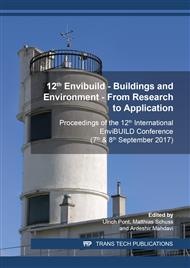[1]
Directive 2010/31/EU of the European Parliament and of the Council of 19 May 2010 on the Energy Performance of Buildings (Rev. V.). Off. J of the European Union L 153/13. (2010).
Google Scholar
[2]
Bundesminister für Land- und Forstwirtschaft, Umwelt und Wasserwirtschaft. Recycling-Baustoffverordnung. Verordnung 181. Bundesgesetzblatt für die Republik Österreich, Austria. (2015).
DOI: 10.7767/boehlau.9783205790341.51
Google Scholar
[3]
Lebensministerium. Bundes-Abfallwirtschaftsplan 2011, Umweltbericht im Rahmen der strategischen Umweltprüfung gem. RL2001/42/EG, Austria. (2011).
Google Scholar
[4]
Lebensministerium. Erläuterungen zur Recycling-Baustoffverordnung. BMLFUW-UW.2.1.6/0306-V/2/2015, Austria. (2016).
Google Scholar
[5]
Paris Agreement. FCCC/CP/2015/L.9/Rev.1. (2015).
Google Scholar
[6]
Information website, https://www.ffg.at/dissertationen/ausschreibung2015, project is funded by the FFG and the Austrian Foundation for Research, Technology and Development (2017).
Google Scholar
[7]
Project homepage, www.lch.grat.at, project is realised with the contribution of the LIFE financial instrument of the European Union (2017).
Google Scholar
[8]
R. Wimmer, H. Hohensinner, M. Drack et al., S-House – Innovative Nutzung von nachwachsenden Rohstoffen am Beispiel eines Büro- und Ausstellungsgebäudes. Berichte aus Energie- und Umweltforschung 2/2005. Bundesministerium für Verkehr, Innovation und Technologie. Vienna, Austria. (2005).
DOI: 10.1002/cite.3307109173
Google Scholar
[9]
B. Krick, Untersuchung von Strohballen und Strohballenkonstruktionen hinsichtlich ihrer Anwendung für ein energiesparendes Bauen unter besonderer Berücksichtigung der lasttragenden Bauweise, University Press Kassel, Germany. (2008).
Google Scholar
[10]
Meteonorm, Climate data Böheimkirchen, Meteonorm database V7.1.2.15160. (2016).
Google Scholar
[11]
M. Kottek, J. Grieser, C. Beck, B. Rudolf, and F. Rubel, World Map of Köppen-Geiger Climate Classification updated. Meteorol. Z. 15. (2006) 259–263.
DOI: 10.1127/0941-2948/2006/0130
Google Scholar
[12]
EnergyPlus, U.S. Department of Energy's (DOE), Building Technologies Office (BTO), National Renewable Energy Laboratory (NREL), https://energyplus.net/. (2017).
Google Scholar
[13]
SketchUp, Trimple Inc., https://www.sketchup.com. (2017).
Google Scholar
[14]
Openstudio, U.S. Department of Energy's (DOE), Office of Energy Efficiency and Renewable Energy, https://www.openstudio.net/. (2017).
Google Scholar
[15]
GenOpt, U.S. Department of Energy's (DOE), Lawrence Berkeley National Laboratory, https://simulationresearch.lbl.gov/GO/index.html. (2017).
Google Scholar
[16]
GEQ, Zehentmayer Software GmbH, https://www.geq.at/. (2017).
Google Scholar
[17]
S. Attia, E. Gratia, A. De Herdea, J. L.M. Hensen, Simulation-based decision support tool for early stages of zero-energy building design, Energy and Buildings 49. (2012) 2–15.
DOI: 10.1016/j.enbuild.2012.01.028
Google Scholar
[18]
M. Wetter, Design Optimization with GenOpt, Building Energy Simulation User News, V. 21. (2000) 19–28.
Google Scholar
[19]
Baubook database, information on https://www.baubook.info. (2017).
Google Scholar



